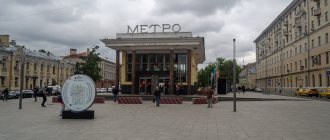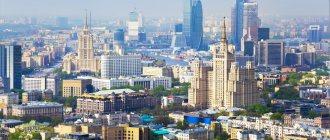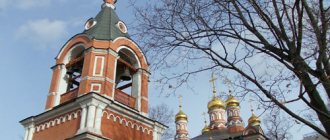Patriarch's Ponds are not only a specific body of water, but also a microdistrict, a public garden in the Presnensky district of Moscow, near the Garden Ring. This is a quiet place, almost in the center of the city, as if created for walks and leisurely conversations in the shade of trees. This is where fans of M. Bulgakov’s work strive to get on excursions in the footsteps of the novel “The Master and Margarita.”
"Patriarch's Ponds" in Moscow - a pond with swans and a quiet park
Everything here breathes mysticism, mystery and antiquity. It was here that the unfortunate Berlioz, Bezdomny and the legendary Woland met. The spirit of old Moscow is best felt at the Patriarch's Ponds. There are many benches and trees whose age is estimated at decades. In the evening, the lights come on and the park is illuminated with a pleasant soft light.
An area of Moscow with an interesting history
At the beginning of the 17th century, on the site where the Patriarch's Ponds are located today, Patriarch Hermogenes built a residence.
The presence of the patriarchal person left its mark on the development of the area. Churches were built here, and religious and industrial activity was in full swing. However, the patriarch chose a strange place to set up his residence - there were swamps nearby. For a long time they were called goat farms, since the Goat Yard was located nearby, which was engaged in breeding and grazing goats, and supplying goat meat for the needs of the royal household. The swamp place had a bad reputation associated with the robbery of dashing people, and with the evil spirits that, according to local residents, lived here.
The next Patriarch Joachim took decisive action to improve the area. He ordered the swamp to be dried out and reservoirs to be built in its place. Three reservoirs were dug - fish were bred in them and eaten.
Peter I did not allow the clergy to strengthen power, therefore, instead of the patriarch, a secular institution, the Holy Synod, began to lead the church from 1721. In the past, a prosperous economy in the Patriarchal Settlement fell into decay, and along with it the ponds turned back into a swamp.
After the expulsion of Napoleon, the city authorities decided to get rid of the swamp: two reservoirs were filled in, leaving one - the Great Patriarchal. They cleared it of vegetation and silt. They improved the area around it, turning it into a public garden. Since that time, the ponds have become a place of recreation for city residents.
After the revolution, in 1924, the territory began to be called Pioneer Ponds, although none of the local residents used this toponym. It was only in 1993 that the place officially regained its former name.
History of creation
It is correct to call this place “Patriarch’s Pond” because there is only one pond, although previously there were actually several ponds here. Until the 17th century, this territory was occupied by the Goat Swamp: next to it there was the Goat Yard, from which wool was sent to the royal and patriarchal courts. These places in the city enjoyed a bad reputation: traces of robberies and murders were lost in the quagmire.
At the beginning of the 17th century, the residence of Patriarch Hermogenes was established here, and the Patriarchal Sloboda appeared on the site of the swamp. In 1683–1684, by order of Patriarch Joachim, 3 ponds were dug for breeding fish for the patriarchal table.
There were similar fish cages in other parts of Moscow: expensive varieties of fish were bred in Presnya, and for daily needs in the Goat Swamp. The memory of this remains in the name of Trekhprudny Lane. After the abolition of the patriarchate, the ponds were abandoned and became swampy.
And at the beginning of the 19th century, the ponds were buried - only the decorative Great Patriarchal Pond was left. A park was built around it. In 1924, the Patriarch's Pond and Patriarch's Lanes were renamed Pionerskie. But the pond was still called Patriarchal.
In 2003, the Patriarch's Ponds and the surrounding park were reconstructed: the banks were strengthened, trees were planted, sidewalks were paved in the park, the pond was cleared of debris and silt, and fish were released into it. In the same year, the Patriarch's Ponds were classified as cultural heritage sites.
The park complex occupies 2.2 hectares, of which 6,323 m² are allocated to paths and playgrounds, and 7,924 m² to green spaces. The pond area is 9900 m², its depth reaches 2.5 meters.
In 2015, the park removed parking along the sidewalks and hid all the wires underground. The nameless square at the intersection of Spiridonyevsky and Bolshoi Kozikhinsky lanes was named Bulgakov Square.
In 2021, a reading room was installed on the Patriarch's Ponds - an open-air area for reading and exchanging books, and chess games were resumed in the cultural center after a long break.
Cultural center and cafe “House on Patriarshikh”
In the same year, the Patriarch's Ponds became an exemplary place for recreation by the water in Moscow. The pond is maintained with funds from federal, municipal, private investors and wealthy people living in the area.
Interesting Facts
- There are many stories and legends associated with the Patriarch's Ponds that cannot be called anything other than mysticism. So, as long as people who lived in this area remember, animals and unwary travelers disappeared in the swamps and then ponds. No one was able to find them either alive or dead.
- Events incomprehensible to the common man occur in this place even today: cars stall, radios stop working. Everyone who lives near the ponds can tell a terrible or touching story that happened to him or his friends at the Patriarch's. And what happened has no reasonable explanation. To believe or not to believe the stories is everyone’s business.
Questions and answers
What are the closest stations to Patriarch's Ponds?
The closest stations to Patriarch's Ponds are:
Metro "Mayakovskaya" is 388 meters away, 6 minutes on foot.
Which Metro lines stop near Patriarch's Ponds?
These Subway lines stop near Patriarch's Ponds: 2, 7.
Which Train lines stop near Patriarch's Ponds?
These Train lines stop near Patriarch's Ponds: Kyiv DIRECTION, KURSKOE DIRECTION.
Which Bus lines stop near Patriarshie Prudy?
These Bus lines stop near Patriarch's Ponds: M6, T39.
Famous people at the Patriarchal
The area of Moscow, where the Patriarch's Ponds were located, began to be actively developed back in the 19th century, and at the beginning of the 20th, representatives of the creative intelligentsia settled here. Marina Tsvetaeva was born and lived for some time in Trekhprudny Lane. Leo Tolstoy came here in winter to skate. Alexei Tolstoy loved to walk along the pond. Alexander Blok lived in one of the alleys for some time. Anton Chekhov rented a house before his trip to Sakhalin. The poet Vladimir Mayakovsky lived in this area. There were workshops here where famous artists Surikov and Polenov created their masterpieces.
In house number 10 on Bolshaya Sadovaya Street lived Mikhail Bulgakov, thanks to whose work the Patriarchs gained fame.
In the seventies of the last century, a monument to I.A. Krylov appeared on the Patriarch’s Square. and the heroes of his fables. In the late nineties, the idea arose to immortalize Bulgakov in a monument, surrounded by the characters of the immortal work, and even a project was developed. The idea was abandoned in time under public pressure.
Bald Mountain
Bald Mountain is not a fiction at all, but a very real place on the territory of modern Bitsevsky Park. They say that it was this place that Mikhail Bulgakov described as the place where Margarita was initiated. The forest attraction is located 100 meters north of the eastern gate of the Bitsevsky forest park, and is crowned by an ancient temple with 4 idols of ancient gods in the middle, protective statues of snakes on the sides and altars.
If you believe the urban legend, despite its location quite close to the entrance, the temple does not allow everyone to approach it: they say, unknowing people just stumbled upon it, while those who deliberately went to the ancient idols could wander for hours, and so on and did not achieve their goal. But rumors about the energy of Bald Mountain vary: some claim that the temple exudes calm, while others feel uncomfortable and dream of getting away as quickly as possible. And pagans and Satanists alternately appear on the temple - the latter at one time even tried to set fire to the ancient structure, damaging several carved runes.
Patriarch's Ponds at the beginning of the 21st century
In modern Moscow, the Patriarchs are given special attention. At the beginning of the 2000s, the facility was reconstructed on a large scale:
- cleaned the pond;
- strengthened the banks;
- they released the fish fry;
- replaced old trees with new – young ones;
- tiles and paving stones were laid on the paths;
- changed the lighting;
- installed benches:
- They built a children's playground next to the monument to the fabulist.
The pond and the park around it acquired a modern, civilized appearance and became a favorite place for Muscovites to relax. The Patriarch's Ponds have received the status of a cultural heritage site and are under the care and protection of the state.
The pond is not intended for swimming - it is more of a decorative nature. In summer you can feed ducks and swans on the water, and in winter you can go ice skating on the pond. Skates are available for rent.
In the evening, the pond is illuminated by sixteen spotlights, which, playing with light, decorate the winter skating rink, projecting flying snowflakes or images of flowers onto the ice.
Patriarch's Ponds are the place where city holidays are organized: City Day, Maslenitsa, various exhibitions and festivities. There are many places around the pond where you can have a snack and even a tasty meal. Many tourists leave good reviews about the work of the Beryozka bistro, with environmentally friendly and healthy food on the menu. You can have a picnic on the grass on the shore.
Museum Theatre "Bulgakov House"
For those who go to the Patriarch's Ponds in the hope of coming into contact with Bulgakov's theme, we recommend visiting the Bulgakov House museum-theater, which is located nearby - on Bolshaya Sadovaya Street 10. Mikhail Afanasyevich lived here from 1921 to 1924 in apartment No. 50. in it, a “bad apartment,” many of the events described in “The Master and Margarita” took place.
The permanent exhibition of the museum includes old photographs, documents, medical instruments of Bulgakov, etc. You will become familiar with the master’s work through an electronic exhibition, which contains all the written materials, photographs, films shot based on Bulgakov’s motifs.
The museum organizes tours of the night capital, places associated with Bulgakov and mysticism. The museum-theater hosts theatrical performances, music concerts, exhibitions, seminars, etc. The State Museum of Mikhail Afanasyevich Bulgakov is also opened in the house. You can find out more about the institution’s exhibitions, excursions, and ticket prices by visiting the official website.
The institution is open from Tuesday to Sunday inclusive, the day off is Monday. Opening hours: from 12:00 to 19:00 and from 14:00 to 21:00
How to find Patriarch's Ponds
The Patriarch's Ponds, one of the most beautiful sights in Moscow, are hidden in courtyards among numerous alleys. If you look for where an object is located on a map of Moscow, you must first find the Central Administrative District. Then find Malaya Bronnaya. To the west of it is the desired place. The ponds are bordered on the northern side by Ermolaevsky, on the south by Bolshoi Patriarchal Lane, and on the western side by Maly Patriarchal Lane.
To get to the reservoir, it is best to walk from the Mayakovskaya, Tverskaya, Barrikadnaya, and Pushkinskaya metro stations. The distance from any station is no more than a kilometer. Therefore, a walk that you take on your own in the city center, especially along the side streets, will delight you with the contemplation of the architectural buildings of old Moscow.
From Mayakovskaya you need to move along Bolshaya Sadovaya and, having reached Malaya Bronnaya, turn left. Bolshaya Sadovaya is a noisy street, and if your plans do not include visiting the Bulgakov House theater-museum there, then it is better to get to the place from the Pushkinskaya or Tverskaya metro stations. Exit along the metro crossings towards Bolshaya Bronnaya. You can then follow it and, having reached Bolshoy Kozikhinsky Lane, turn right, then turn left at Maly Kozikhinsky Lane. After a few tens of meters, the surface of the pond will open in front of you. You can choose a shorter route - through Maly and Bolshoi Plashevskie lanes. Whatever road you choose, all alleys will lead you to the Patriarchs, who have the exact address. They are located on Bolshoy Patriarshiy Lane, 7/1.
If you don’t want to go, then Moscow taxi drivers will answer your question about how to get to the Ponds.


